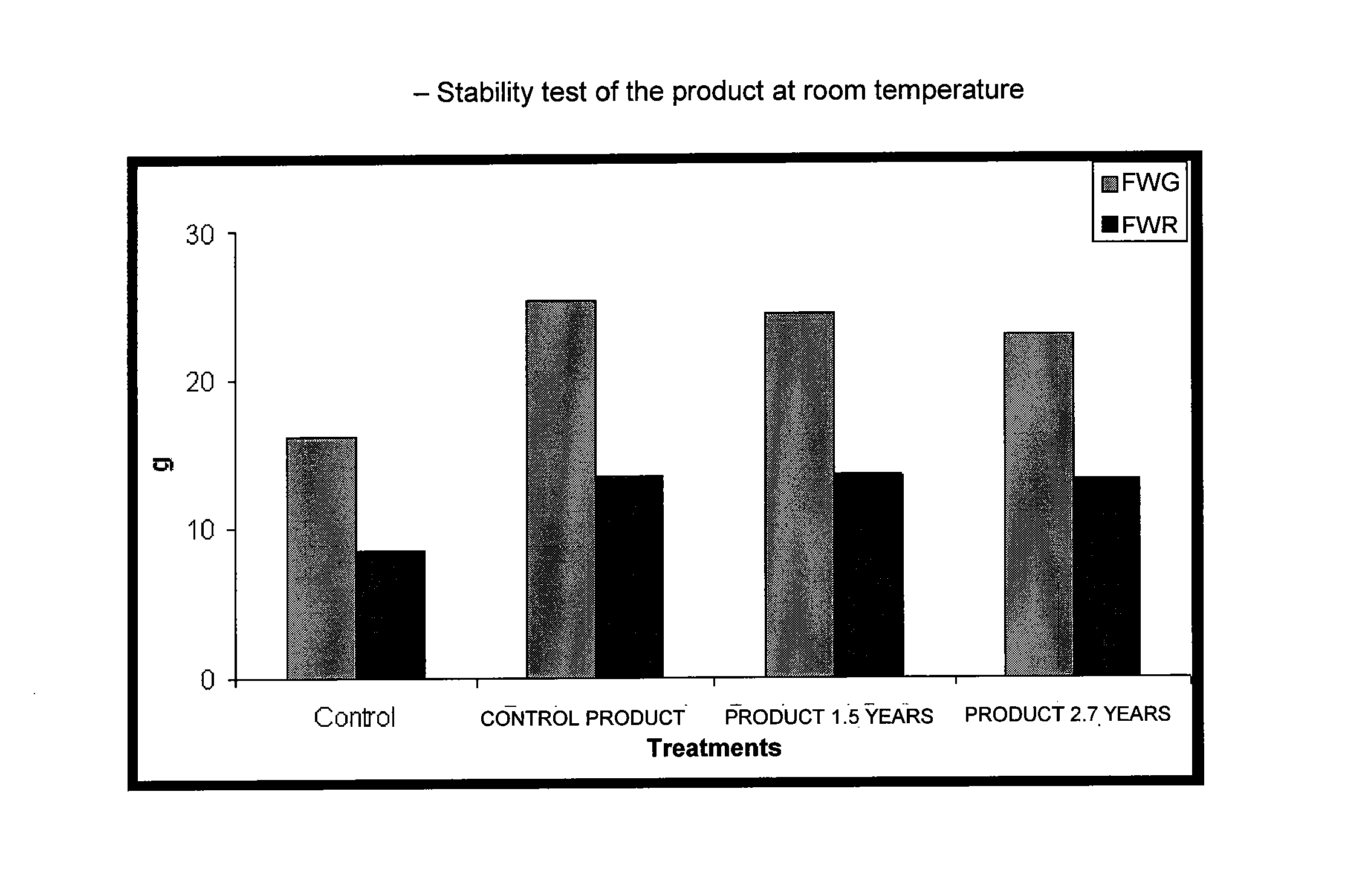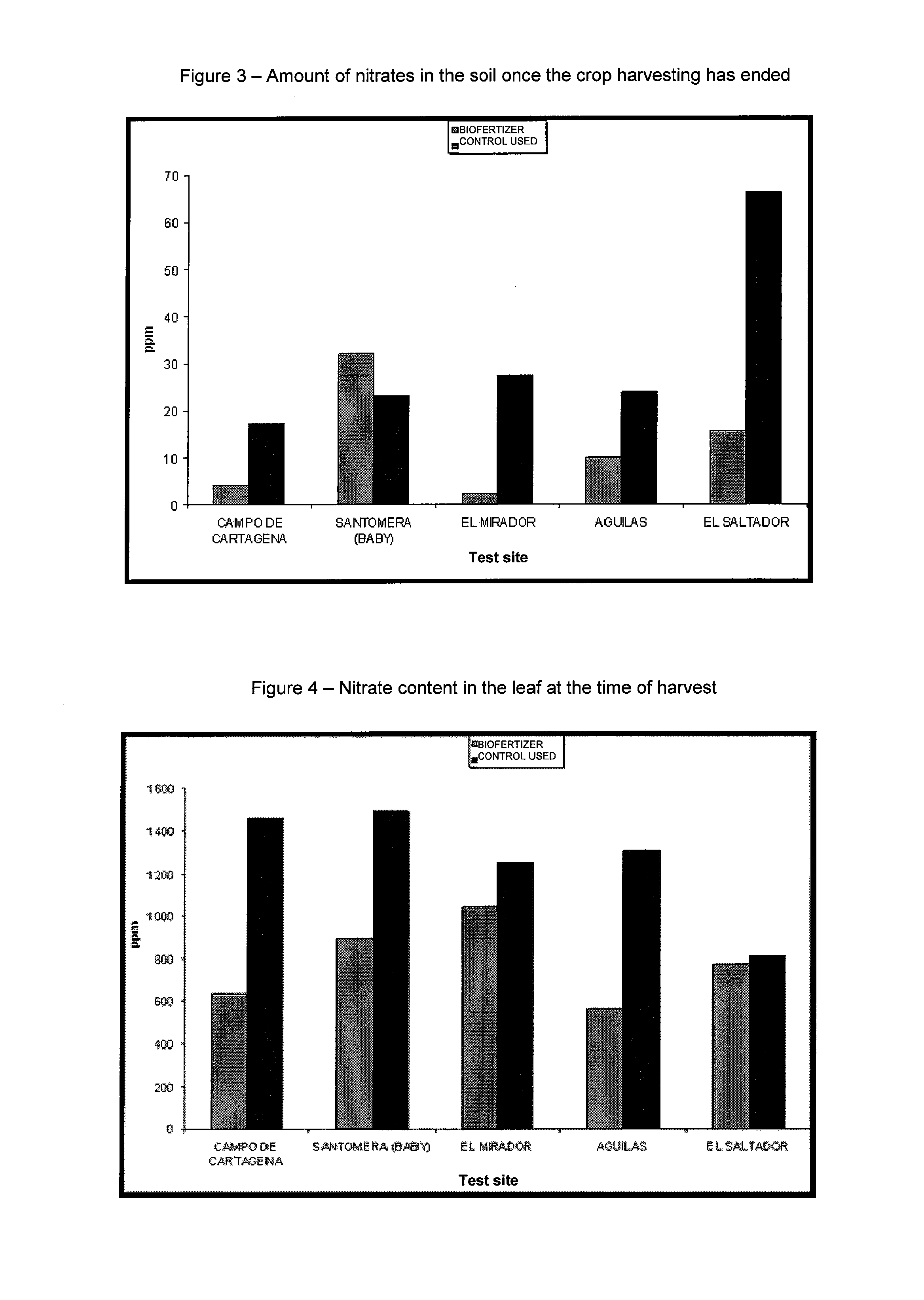Biological fertilizer, method for obtaining same and use thereof as a plant growth stimulator
a technology of biological fertilizer and stimulator, which is applied in the direction of biocide, bacteria based process, inorganic carrier, etc., can solve the problems of inability to use phosphorus applied by means of fertilization by crops, low availability of these elements, and considerable environmental pollution problems, so as to reduce residual moisture, reduce the temperature of drying air, and increase the contact area
- Summary
- Abstract
- Description
- Claims
- Application Information
AI Technical Summary
Benefits of technology
Problems solved by technology
Method used
Image
Examples
example 1
Propagation of Strains Azospirillum brasilense M3 and Pantoea dispersa C3
[0064]A blister of the preserved isolate of strain M3 is taken, is seeded on Congo Red medium plates (Rodríguez Cáceres, 1982) and is incubated at 30° C. for 72 hours in order to verify its purity. An inoculum is prepared from this plate for the fermenter, a portion of the culture being taken with a loop, 3 2000-mL Erlenmeyer flasks are each inoculated with 750 mL of tomato medium without L-tryptophan and are incubated under stirring at 30° C. for 14-16 hours. After this time, the content of the flask, which is in exponential phase, is inoculated in a Braun Biotech BIOSTAT® C 30 L fermenter with 18 L of tomato medium without L-tryptophan. It is cultured for 8-10 hours and when it has reached high cell concentration and is still in exponential phase, it is inoculated in a Braun Biotech BIOSTAT® D 300 L fermenter with 200 L of tomato medium. The fermentation is carried out for 24-36 hours at a stirring rate of 2...
example 2
Cell Immobilization and Loading of Nutrients
[0067]A plow mixer having a sprayer is used to carry out this process and the following raw materials are used:[0068]97.5 Kg of zeolite[0069]2.5 Kg of phosphorus rock[0070]3.6 L of M3 broth[0071]3.6 L of C3 broth
[0072]The mixer is loaded with zeolite and phosphorus rock and the process of mixing is carried out for 5-10 minutes. Then, and maintaining the mixer in motion, the broths of cells are sprayed in sequential order, first M3 and then C3. The process of adsorption of the nutrients is carried out using the following raw materials and proportions upon finishing and with the mixer in motion in order to obtain a homogenous wet solid:
(NH4)2SO4590g / L3.83 L of solutionK2HPO4550g / L1.05 L of solutionZn(NO3)2•4H2O122.5g / L0.15 L of solutionMnSO4•H2O120g / L0.15 L of solutionCuSO4•5H2O24g / L0.05 L of solutionFeSO4•7H2O24g / L0.05 L of solution
[0073]Without stopping the mixer, each of the solutions described above is sprayed sequentially and in the sam...
example 3
[0075]The fluid bed dryer is fed with the mass necessary for its operation and it is operated at a maximum air temperature of 35° C. The product will thus be gradually dried until reaching a final moisture that will be between 2-3% which is the moisture value of the finished product.
[0076]The cell viability of this product will be verified periodically in Congo Red medium (Rodríguez Cáceres, 1982) for Azospirillum brasilense M3 and in MacConkey medium (OXOID 1981) for Pantoea dispersa C3, finding that over 90% of the activity thereof is preserved over more than two years of storage at temperatures not greater than 35° C. It is obvious that the combined process of immobilization and adsorption of nutrients, which allows greater saturation of the support, and the drying temperature of 35° C., which is much lower with respect to the drying temperature according to the prior state of the art, and which acts very favorably on cell survival in the process of storing the product, hav...
PUM
 Login to View More
Login to View More Abstract
Description
Claims
Application Information
 Login to View More
Login to View More - R&D
- Intellectual Property
- Life Sciences
- Materials
- Tech Scout
- Unparalleled Data Quality
- Higher Quality Content
- 60% Fewer Hallucinations
Browse by: Latest US Patents, China's latest patents, Technical Efficacy Thesaurus, Application Domain, Technology Topic, Popular Technical Reports.
© 2025 PatSnap. All rights reserved.Legal|Privacy policy|Modern Slavery Act Transparency Statement|Sitemap|About US| Contact US: help@patsnap.com



